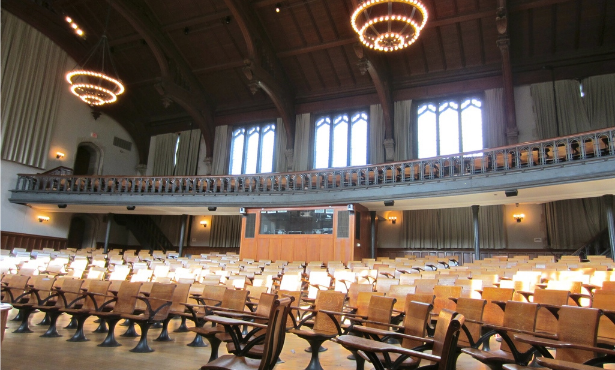Is the Lecture Dead?
Education isn't just about conveying information as efficiently as possible. A lecture, done right, gets to the heart of why a lesson is worth learning.

The nation's 80,000 medical, 20,000 dental, and 180,000 nursing school students might think that lectures are dead, or at least dying. Health professions curricula increasingly feature small-group, interactive teaching, and successive waves of enthusiasm have arisen for laptops, PDAs, and tablet computers as the new paradigms of learning. Commentators frequently single out the lecture as the prototypically old school, obsolete learning technology, in comparison to which newer educational techniques offer interactive, customized, and self-paced learning alternatives.
This is no arcane academic matter. The LCME, the organization that accredits US medical schools, strictly limits the number of hours per week students may spend in lectures. So seriously does the organization take this mandate that, in October of 2011, it placed one of Texas's medical schools on probation, in part because its curriculum relied too heavily on "passive" approaches to learning -- foremost among them, lectures. In medical education circles, "lecture" is fast becoming a term of derision.
And yet, recalling the words of Mark Twain, widespread reports of the lecture's demise are somewhat exaggerated. I believe that we should revisit this venerable educational method before we sign its death certificate. To be sure, some lectures seem to exert a narcotic effect on the attention and enthusiasm of learners, and there are more than a few lecturers in health professions schools whose impact can best be described as deadening. But there are boring small group sessions, too, and even some new, highly touted technologies have turned out not to enliven education.
In other words, there are good lectures and bad lectures, just as there are good lecturers and bad lecturers. Rather than disposing entirely of the lecture as a means of learning, we should attempt to understand better the features that distinguish effective, engaging lectures from those that leave learners limp. Good lecturing is an art, and like other arts such as painting, musicianship, and writing, it takes real dedication and many hours of practice to excel at. Some may be more gifted at lecturing than others, but through study and practice, nearly everyone can improve, some of us substantially.
To begin with, we lecturers must ask ourselves a basic question: why am I lecturing? What will I be able to get across to learners through a lecture that they could not get just as well and with less inconvenience by reading a book or working through an online learning module? The answer, in part, must be that the physical presence of the lecturer and the unfolding of the lecture in real time will make a difference for learners. Great lecturers not only inform learners, they also engage their imaginations and inspire them.
The core purpose of a great lecturer is not primarily to transmit information. To this end, other techniques, such as assigning a reading in a textbook or distributing an electronic copy of the notes, can be equally effective. The real purpose of a lecture is to show the mind and heart of the lecturer at work, and to engage the minds and hearts of learners. Is the lecturer enthusiastic about the topic? Why? Could I get enthused about this, too? How could I use this to take better care of my patients? Is this the kind of doctor or nurse I aspire to be some day?
A great lecturer's benefit to learners extends far beyond preparing for an exam, earning a good grade, or attaining some form of professional certification. The great lecture opens learners' eyes to new questions, connections, and perspectives that they have not considered before, illuminating new possibilities for how to work and live. Without question, it also helps learners who pay attention earn a better grade, but it manages to make the topic take on a life of its own and seem worth knowing for its own sake, beyond such narrow, utilitarian advantage.
Consider, for example, the x-ray, one of the most important scientific and technological advances in the history of medicine. A lecturer could merely show students what x-rays are, how they work, and what they need to know for the exam . But the same information can be embedded in a much more engaging context, one that explores how the ability to peer inside the living human body without the use of a scalpel has changed daily practice, and how it has touched and transformed the lives of real patients, many of whom are alive today because of what x-rays revealed.
A great lecturer tells a story. It has a beginning, a middle, and an end. It poses problems that it proceeds to address, and it keeps learners in suspense, waiting to see how they can be worked out. Great lecturers often share responsibility for solving these problems with learners, working with them in real time to find a solution. Learners are not merely sitting and passively listening. Far from it, they are challenged and engaged, actively thinking and imagining right along with the lecturer as both struggle toward new insights.
To excel as a lecturer, it is necessary to find delight as a lecturer. In part, this means ferreting out what is most intriguing about the topic under discussion. It also means attending carefully to learners and seeking and sharing their enthusiasm. A great lecture is not a rote mechanical reading of notes, but a kind of dance, in which lecturer and listeners watch, respond to, and draw energy and inspiration from each other. One of the greatest pleasures of lecturing occurs when learners pose insightful questions that the lecturer did not -- perhaps even could not -- foresee.
The wisest of the apostles of new educational technologies recognize the power of the lecture. Randy Pausch, professor of computer science, human-computer interaction, and design at Carnegie-Mellon University made perhaps his greatest educational contribution not through a new computer interface but through his famous last lecture, delivered in 2007. Though dying of pancreatic cancer, Pausch's presentation on "Really Achieving Your Childhood Dreams" showed a lecturer on fire with ideas and brimming over with an infectious enthusiasm for discovery and for life.
Steve Jobs' 2005 commencement address at Stanford University embodied a similar spirit. In it, Jobs tells three stories, one about dropping out of Reed College after 6 months, the second about his firing by the board of directors at Apple, and the third about being diagnosed with pancreatic cancer. Each is a story about loss, even failure. Yet over the course of his presentation, Jobs conveys the powerful message that his successes were born from his failures and wouldn't have been possible without them. Ultimately, his message is about courage, the courage to follow your heart.
Pausch and Jobs could have confined their presentations to small groups, relying on much more direct interaction with a few audience members. They could have embedded their messages in interactive computer software programs that asked learners numerous questions and provided constructive feedback on their responses. They could have phoned their lectures in, using the latest distance-learning technology. Fortunately, however, they did not, and our world and the world of today's health professions students is the richer for their choice to lecture.
Pausch and Jobs are great lecturers, not because they convey information with maximal efficiency, but because they get us thinking about our lives from fruitful new perspectives and help us to seek out and find new meaning in the work we do every day. Some might say that faculty in the health professions dare not aim so high, because they need to get across basic facts about anatomy and pathology and the like. But anatomy and pathology are foundational elements of human life, and each offers the opportunity to tell great stories that engage the human spirit.
While I was not present at the lectures by Pausch and Jobs, I have personally witnessed great lecturers in action, and I would rank their presentations among the most transformative educational experiences of my life. To rid health professions education of lectures would be a grave error. Nor can efforts to cut down on the amount of lecturing be justified on the grounds that the lecture is dead or even moribund. As Pausch and Jobs remind us, the lecture remains one of our most precious educational resources. Our mission is not to supplant it, but so far as we can, to perfect it.
><
